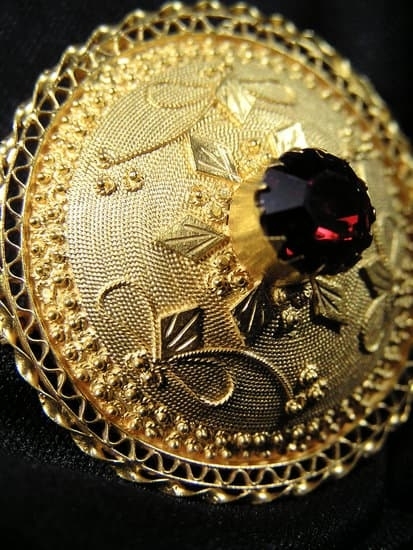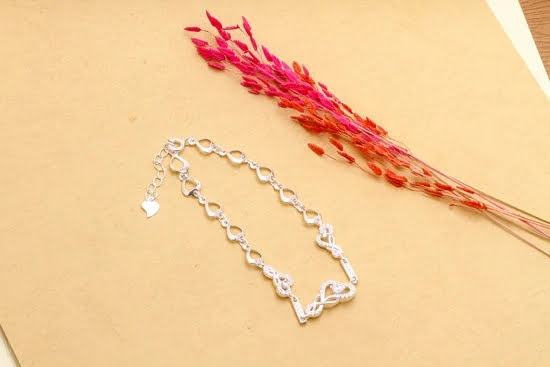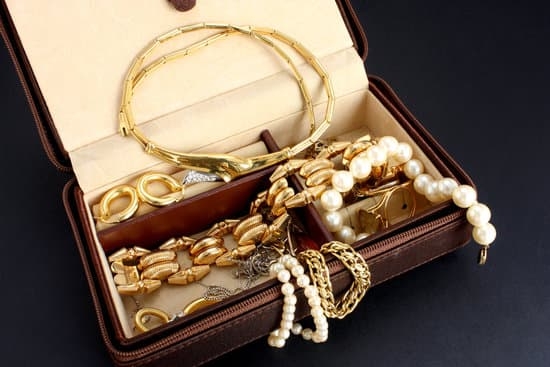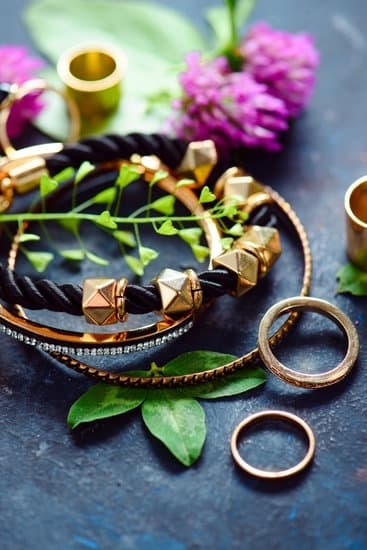The history of amethyst jewelry can be traced back hundreds of years ago, with references found in different cultures around the world. Ancient Greek and Roman writers placed a high value on the gemstone and used it to adorn religious artifacts, royal treasure and everyday items decorated with elaborate motifs. Over time, amethyst has become one of the most prized gemstones, valued for its violet hue that was believed to convey mental clarity, sobriety and divine protection.
In addition to being held as a symbol of royalty throughout many centuries in Europe, amethyst was also known as the mythical healing stone in ancient times. Legends say that if you drink from a cup made from an amethyst stone or wear it as jewelry on your body, you will have the power to control passions such as anger or lust.
Moreover, it is thought that having an amethyst close to you will also heal physical injuries faster than normal. This belief was so deeply rooted that some cultures even filled vessels with wine infused with amethysts so they would have this luminous purple flavor at social events.
Today, there are still many who seek out healing or clarifying powers by wearing jewelry crafted with this luscious colored stone but it’s no longer restricted to only royals or spiritual traditions like in past times. Instead, modern trends have caused these exquisite jewels to become more accessible while still retaining its charm.
Whether a tall statement piece executed by master craftsmanship or a more delicate daily-wear necklace consisting of small Amethyst beads; these pieces come alive when someone wears them due to its unique vibes associated with love and self-esteem. Although modern fashion has brought about an array of different models embellished with this beautiful gemstone conforming to all styles; one thing remains steadfast: Ancient beliefs which proclaim the healing properties gifted by wearing Amethyst remain strong despite our evolution.
Ancient Use and Meaning of Amethyst Jewelry
The use of amethyst jewelry dates all the way back to early civilizations in Ancient Greece and Rome. The word ‘amethyst’ is derived from the Greek word ‘amethystos’, which means ‘not drunken’. In Ancient Greece, it was believed that amethyst had the ability to prevent intoxication; therefore it was often worn by believers, soldiers, and priests as protection.
Amethysts were believed to have several healing and medicinal powers such as curing gout, mental illness, snake bites and insomnia. People also believed that wearing an amethyst could increase wealth and good fortune.
During the Middle Ages, amethyst jewelry was seen as a symbol of humility and royalty. It was a popular gemstone amongst royalty and clergymen because it was thought to represent selflessness, chastity, piety, innocence and sincerity. Most often rings were crafted with a large amethyst set in silver or gold for a royal or important figure in society.
In modern times amethysts are still used in various types of jewelry from crosses and crucifixes to classic evening sets of earrings and necklaces. Since the availability of amethysts has become more widespread they have become much more affordable allowing everyone to own an item of jewelry with this beautiful stone included in it.
Amethysts are an especially versatile gemstone because their many nuances allow them to be set with other stones or metals with ease creating both subtle effects but also bold fashion statement pieces alike. They have been used traditionally used to mark specific occasions such as birthdays or anniversaries due to their special meaning around stability within relationships making them a very romantic choice for couples everywhere today.
This can be said for why many engagement rings contain this powerful stone; having an unequalled glow when presented in a piece of jewelry fit for eternity.
Amethyst Jewelry in Different Cultures
Amethyst is an incredibly old form of jewelry, with pieces found in ancient settlements from many different cultures around the world. In fact, it has been used since antiquity in special ceremonies and for its believed spiritual properties. Ancient Greeks and Romans wore amethyst jewelry due to the spiritual power associated with it.
They believed that the stone had healing properties that could provide mental clarity and support sobriety. The color of amethyst would often depend on how one culture perceived its spiritual significance; some saw purple as a holy color while others looked at blue.
For centuries, weavers in Mexico made beautiful handwoven pieces of jewelry featuring amethyst gemstones to use during ceremonial occasions such as weddings. In Central American countries this stone was placed inside tombs as an offering to ancestor spirits, showing that they believed in their afterlife connection with those who came before them.
In Asia, protective amulets made out of or carved into amethyst were used by Buddhist monks as symbols of protection against evil forces and bad luck. Commonly known as fat petchies, these talismanic objects also served to create strong energetic connections between the bearer and the wearer’s ancestors or higher power source.
Not only did monks wear these protective amulets but so too did many religious people around the world for thousands of years – both Buddhist and non-Buddhist alike have been using them for millennia.
Today, those wearing Amethyst Jewelry will appreciate its beauty and elegant detailing along with any energy deity might possess. Wearing this gemstone will attract good luck whilst creating amazing aesthetics around your neck and wrist.
Necklaces look particularly feminine when you pair them up with lighter shades of purples and blues; while rings can attract attention when set against color stones like garnet or emerald adding extra sparkle to this natural beauty making your outfit complete and giving you a glamorous look at the same time.
Amethyst is highly sought after today due to its variety of shapes, cuts, hues & shades which all make it unique & precious. From earrings to pendants or even a simple bracelet, Amethyst Jewelry always catches attention no matter what type you choose.
Types and Styles of Amethyst Jewelry Through the Ages
Amethyst jewelry has a long and interesting history, going back to ancient times. The ancient Greeks and Romans wore it in abundance and there are references to this gemstone being favored by royalty centuries ago.
It is believed that the word amethyst is derived from the Greek words “a” and “methustos”, which means “not intoxicated”, as the gemstone was thought to have the properties of helping its wearer to remain sober. Amethyst was regularly said to be able to strengthen one’s inner strength and ward off evil, while also giving wisdom and courage.
Throughout history, amethyst jewelry has been produced in various forms. In Medieval times, knights would often wear crosses made with an amethyst center stone, for protection against danger and illness. Similarly, during the Renaissance, rosaries were given to brides on their wedding day as a symbol of faithfulness and devotion. Furthermore, from the late 17th century onwards, lockets containing amethysts were popular among wealthy women of nobility as a way for them to show off their wealth.
At about this time, Georgian period jewelers began working with delicate new settings such as foiled-back gems or colored stones set into precious pieces – most notably cameos or intaglios featuring romantic scenes or cameo carvings set in hand-designed frames of gold formed with cabochon-cut stones like amethysts which created maximum opulence around these prized purple beauties.
The Victorians placed heavy emphasis on symbolism in ring designs involving a variety of different stones used together with their own personal meaning; an example would be featuring textured initials representing each family member while highlighting the amethyst at the center – thus representing unity within one household.
Today, modern fashion trends have further embraced the beauty of this striking gemstone with endless possibilities for design incorporation for necklaces pendants earrings rings bracelets cufflinks brooches belts headpieces tiaras veils and any other custom projects you can dream up.
Whether alone set alongside diamonds white sapphires emeralds rubies or other precious colors-the soft complexity that comes from perfectly cut pieces brings another layer of sophistication when creating timeless classic staples along with modern glamour styles both fit for royalty.
Popularity of Amethyst Jewelry During the Middle Ages
In Europe during the Middle Ages, there was a growing demand for amethyst jewelry. This was the time of the Black Plague and superstition was rampant across Europe. People believed that wearing amethyst jewelry could help ward off sickness. The belief grew so popular that at one point, it was banned in monarchies because they feared it would bankrupt their treasuries.
The presence of amethyst jewelery in Christian ceremonies also increased its popularity as a holy stone. Amethyst jewelry was integral to the attire of high clergy such as Bishops and Cardinals, who wore them on their mitres. Royalty also saw an appeal in the gemstone’s subtle coloring and its associations with luxury and power began to spread from court to court throughout Europe.
Amethysts were so coveted during this period of history because they were quite rare despite being found all over the world. This led to people believing that it had mystical powers that provided protection against misfortune and evil forces. As a result, many wealthy families began buying up all of the available amethyst stones at various markets throughout Europe and demand eventually outgrew supply which caused prices of amethysts to skyrocket even further beyond what they already were.
Amethys stones remain fashionable even in our current digital age, mirroring typical fashion trends with new designs created each season by top designers like Cartier and Tiffany & Co featuring stunning amethyst pieces. With its deep colours ranging from pale lilac to dark plum, it appears as necklaces, earrings, rings, brooches and more–making it easy for anyone to look effortlessly chic while wearing these special pieces of jewellery.
Amethyst Jewelry in the Victorian Era
The Victorian era is most famously known for the beloved jewelry trends of the time due to Queen Victoria’s influence as she often dressed in beautiful stripes of amethysts and was known as an advocate for them. Gemstones like opals, pearls, and sapphires were all popular during this time; however, none could outshine the stunning purple color of an amethyst.
Women would often don ornate necklaces that draped down passed their waist or wore intricately designed earrings in a variety of shapes and sizes.
During this era, it was customary for young people to be gifted with pieces adorned with amethysts on special occasions such as birthdays or Christmas as a way to display love and admiration. Men would also gift their girlfriends with rings laden with valuable stones so that they could symbolize their commitment toward one another.
The popularity of gifts such as these grew immensely during this period, making it commonplace to see various types of precious jewels around town and in households across the country.
As gold became more readily available during the Victorian era, many began to incorporate it into pieces alongside their renowned amethyst stones. Brooches featuring unique designs such as hearts were especially sought after by both men and women alike because of how well gold contrasted against the deep purples found within an amethyst stone and allowed them to become more luxurious in appearance than ever before.
Furthermore, smaller pendants took on new forms thanks to Victorian innovation which made them even more cherished among those during this age period.
Contemporary Explorations of Amethyst Jewelry
The history of amethyst jewelry dates back to Ancient Greece, where the purple-colored quartz was believed to have mystical powers. Amethyst has been used in a variety of pieces dating back centuries, ranging from rings to necklaces, crowns, and even goblets. Ancient Greeks and Romans also used it as one of the Twelve Stones in High Priest Aaron’s Breastplate.
In traditional cultures that venerated amethyst as sacred and sacred stone, it was thought to bring wisdom and clarity as well as calmness when worn around the neck or held in the hand. In some cultures, amethyst was favored for use in jewelry making because it was thought to encourage sobriety among drinkers due to its purplish color resembling wine stains.
The many beliefs about this particular mineral attribute continue to add their intriguing characteristics today for those who wear it with intention.
More recently, contemporary artisans continue to explore creative ways utilizing this precious stone. Amethysts are now found embedded with semi-precious stones like labradorite or blue topaz and added diamond accents providing an unexpected landscape of glamorous designs. Through modern techniques such as electroforming, metalsmithing and laser cutting, these mesmerizing gemstones can be carefully set into unique shapes, chains and clusters that create magical expressions worthy of adornment.
Moreover, beyond aesthetics many spiritual communities today still believe amethyst to be a powerful healing stone with multifaceted gifts that balance energy systems while increasing intuition and creativity while inspiring conscious living through its calming hues which makes wearing the gemstone an even more special experience than ever before.
Caring for Amethyst Jewelry
The use of amethyst in jewelry dates back thousands of years. Amethysts were highly valued and used by the ancient Egyptians, Greeks, and Romans to represent a powerful spiritual protection against negative elements. Amethyst was particularly cherished by early Christian clergy and features prominently in many cathedrals and churches around Europe. Queen Victoria especially loved this precious gemstone and had it included in her personal jewelry collection.
Along with its remarkable history comes the responsibility to care for your amethyst jewelry properly. It is important to remember that as a member of the quartz family, amethyst is quite durable but still requires some special attention when cleaning or storing it. Avoid harsh cleaners such as chlorine bleach or abrasive ruby-jewelry cleansers.
The best option for cleaning your amethyst piece is to soak it overnight in warm, soapy water and then rinse it with a soft cloth or brush. To ensure the longevity of your treasured pieces, never store them in direct sunlight or extreme temperatures, as excessive heat can cause discoloration or warping of the stone.
When wearing your amethyst jewelry, be mindful not to keep it on during rough physical activities that may cause scratches or damage due to its softer nature when compared to other gemstones like diamonds. Additionally, take care not to expose your pieces to any sharp object-especially those containing substances like chemicals-as these could easily scratch or harm the stone’s surface over time depending on the frequency of exposure.
To be extra cautious you could also opt for using an ultrasonic cleaner a few times a year when needed which would help bring out underlying dirt embedded into stone’s crevices undetected by the eye alone. With proper maintenance and storage practices you can look forward to enjoying your dazzling amethyst jewelry pieces for years to come without any issues.
Conclusion
Amethyst jewelry is quite simply stunning, and it has a rich history which makes it even more desirable. Dating back to many different cultures including Ancient Greece, it has been worn for centuries to symbolize wealth, power and protection. It has always been seen as a luxurious stone with strong spiritual properties.
The ancient Greeks valued the purple stone as such that they dedicated it to the god Dionysus – the god of wine and divine intoxication – believing that wearing amethyst would help them keep their minds clear while enjoying all the fine things in life. As such, this sentiment was passed down through history and amethyst jewelry gained fame throughout many different civilizations in Europe and Asia during the Middle Ages.
It wasn’t only European royalty who was drawn to amethyst’s beauty: royalty from India also championed its use in jewelry and during this time; it was said that Hindu Priests used the purple stone to meditate. In Europe, wealthier families commissioned jewellers to craft elaborate pieces with precious metals and finely cut stones – becoming a sign of power, wealth and influence across the continent.
The cost of commissioning such fabulous pieces meant that these items were reserved for only those who could afford them.
In modern times, amethyst Jewellery continues to be favored for its lustrous beauty; often being crafted into striking designs with intricate detailing. Many people enjoy wearing amethyst jewelry today not just for its deep spiritual connections but also because of its overall beauty; radiating an ethereal vibrancy like few other stones can match.
In particular, rings made out of this colour gemstones are among some most sought after pieces desired by both men and women looking to own something truly amazing. Whether you’re looking for something elegant or bold in style, Amethyst Jewelry will always be sure to make a statement – whatever event you choose to wear it at.

Welcome to my jewelry blog! My name is Sarah and I am the owner of this blog.
I love making jewelry and sharing my creations with others.
So whether you’re someone who loves wearing jewelry yourself or simply enjoys learning about it, be sure to check out my blog for insightful posts on everything related to this exciting topic!





